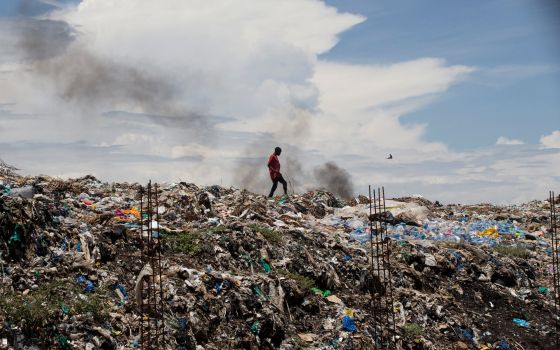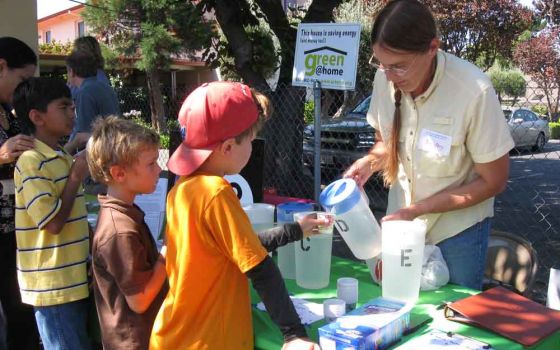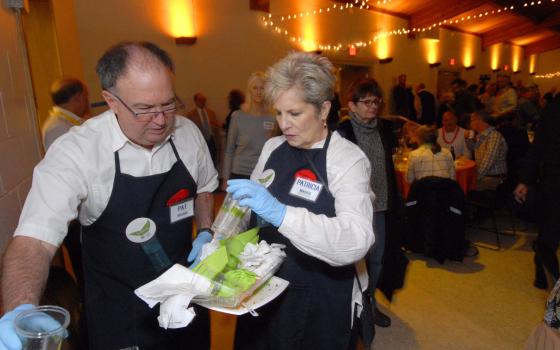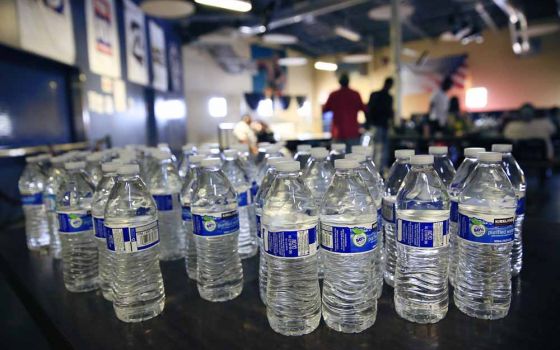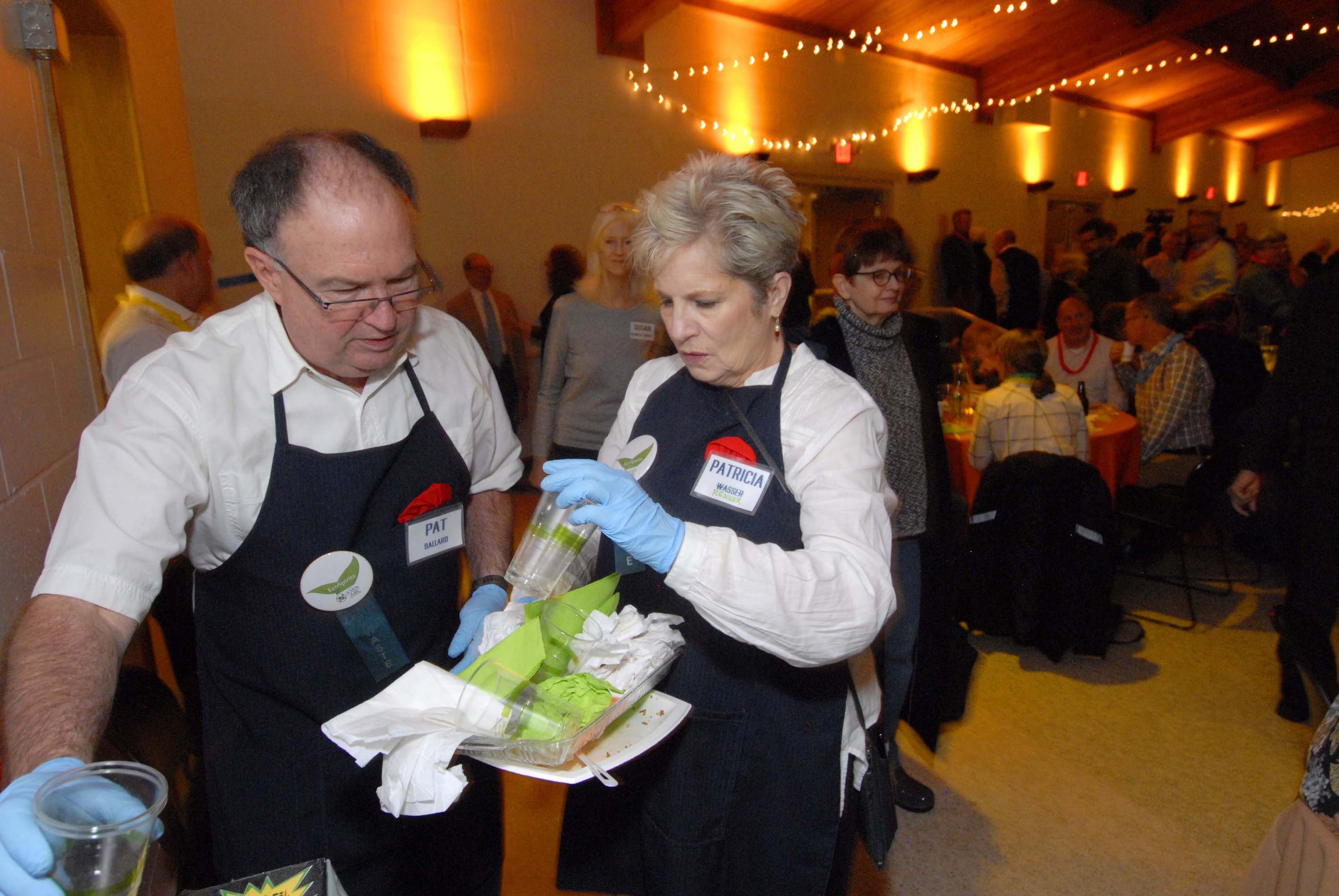
Eco Spirits volunteers Pat Ballard, left, and Pat Wasser deposit organic cups, plates, napkins and utensils into a composting bin during the annual Cabaret fundraiser, at St. Joan of Arc Church, in Minneapolis, in October. (Jeffrey Grosscup)
Jeffrey Grosscup can vividly picture the numbers.
Six hundred to 1,200 people at two Sunday Mass services at St. Joan of Arc Church, in Minneapolis. Many joining for coffee and hospitality afterward.
"Let's say there's 1,000 Styrofoam cups used every Sunday, and that's just going into the trash and it's being incinerated. And it was really unconscionable that we were continuing to operate that way," said Grosscup, a parishioner at Joan of Arc since 1971 and member of its Eco Spirits ministry.
That thinking roughly a decade ago led the parish to make their own transition away from cheap plastic foam cups to corn-based compostable coffee cups.
The move didn't take much convincing, with the parish already thinking about sustainability through the addition to its parish center. A long heavy wooden beam salvaged from the bottom of Lake Superior in the new space serves as a symbol of the parish's commitment to reuse.
But the parishioners involved in Eco Spirits didn't stop there.
With their annual Cabaret, a three-night fundraising arts showcase held each fall, all the elements for a "perfect storm" of potential waste were present: serving dinner and drinks to a large number of people, an outside professional caterer, a limited budget, uncountable little details to plan and prepare, dozens of volunteers and organizers, exhaustion by the end of it all just to clean up quickly, get out and get home.
The latest Cabaret, held over three nights in October and drawing 1,500 guests, amassed just 38 pounds of trash.
"It's a powerful story of what is capable for any organization — a school, Boy Scouts doing the Blue and Gold dinners, whatever it is, an athletic banquet — of what you can do to really cut down on waste if you have a sense of stewardship about it all," Grosscup said.
Through careful planning on the front end, including purchasing green materials at a local party materials store and using light-focused decorations, and dedicated execution by its members at the event itself, the Eco Spirits ministry was able to manage the 1,109 pounds of total waste generated in a way to ensure 97 percent of it was recycled or composted.
Advertisement
Even with the Eco Spirits' zero waste emphasis, Joan of Arc isn't without its own troubles in reducing waste. It's not uncommon for people, though open and willing to recycle, to toss a coffee cup from Starbucks or Caribou into one of the parish's recycling bins. But Grosscup, a certified recycler in Hennepin County, sees those items for what they really are: trash.
"Any time you get a cup from Starbucks, it's not a compostable cup," he said, pointing out the plastic lining on the cup's inside making it incompatible with paper recycling or composting. In March, Starbucks announced it was investing $10 million to develop a compostable cup.
Those changes could help stem the trend of increasing plastic waste in the decades to come. Currently, 5.5 billion tons of plastic waste, or 79 percent of the 9.1 billion tons of plastic produced since the 1950s, ends up in landfill or in the environment, according to a 2017 study in Science Advances. That total is expected to grow to 13.2 billion tons by 2050 without a change in production or waste management.
In the U.S., about half of the 258 million tons of trash generated annually ends up in landfills, compared to 34 percent of it being recycled, according to the 2017 Infrastructure Report Card issued by the American Society of Civil Engineers.
To help in the education of what is and is not recyclable into the parish's three bins — paper and cardboard; glass, plastic bottles and aluminum cans and bottles; and organics — Grosscup has on several occasions after Mass set up a display where he has people sort through 50 hard-to-decipher items, such as plastic razors, toothpaste boxes and egg cartons, and decide if they're recyclable or not, and if so, in what bin to place them.
"It's a real eye-opener for people when they start to look at this. And it just shows how easy we can contaminate that recycle source," he said.
While single-use compostable materials are better than unrecyclable alternatives, the end goal is substituting those with reusable plates and cups. Already, people are encouraged to bring their own mugs to different meetings, and the parish uses ceramic place settings for smaller events. They've taken steps to eliminate water bottles and replace them with water carafes. A future Eco Spirits program will ask parishioners to "take the pledge" to minimize their own use of single-use plastics and materials.
"There's a shame in that, I think, that all these coffee cups and things that we're using, though they can all be compostable, on the front end they're only used once," Grosscup said.
A key part of our Catholic faith
At St. John Neumann Church, in Reston, Virginia, they’ve attempted to skip altogether the recyclable or compostable options for parish functions and, instead, are opting for reusable dishes, tumbler glasses and a professional-grade dishwasher.
"Our real goal is not to buy all this stuff in the first place, so we don't have to recycle it," Ed Sabo, a member of the parish's creation care team, also called Care for Our Common Home, told NCR.
Care for Our Common Home members from St. Mark and St. John Neumann parishes in March toured the American Recycling Center in Manassas, Virginia, to learn how throwaway plastic items are recycled. (Janet Broderick)
He sees value for the parish in the savings coming from not continually buying reams and reams of plates and cups. More than that, members of Care for Our Common Home recognize the value in the parish leading by example to make people more aware of the throwaway culture.
"We really consider this a key part of our Catholic faith. We're just not tree-hugging environmentalists," Sabo said.
Like its neighboring parish St. Mark Church, in Vienna, the Care for Our Common Home ministry at St. John Neumann formed out of a parish study of Laudato Si', in late 2015. It includes about a dozen active participants, and has a mailing list of 60 to 70 people.
"After reading that, we were sort of inspired to try to do something," Sabo said. "Not just read and understand what he [Pope Francis] was saying, but take some practical actions to reduce waste or reduce our energy consumption."
The two parishes have shared knowledge and collaborated on waste-reducing activities. The awareness-building isn't limited just to their consumption of plastic, but why their faith calls them to limit it.
"Some people are noticing it and saying it's a great idea. And other people are saying, well this takes too much time to wash these dishes afterward and put them away. It's just so much easier to throw everything in the trash," Sabo said.
Parishioners at St. John Neumann have been able to put into action their 250 sets of waste-reducing dishes in a number of their ministries: Lenten soup suppers with the Boy Scout troop assisting in the cleanup; a large workshop in February that hosted around 300 people; and at the dinners at a hypothermia shelter the parish hosts in the winter, serving about 100 people in all between visitors and volunteers.
After each event, Sabo does some counting of his own.
"That's 100 people or so who reuse our plates and utensils. So that's five nights times 100 plates we saved there," he said.
The last straw
The slurping sounds of emptying drinks are less prevalent in Dignity Health hospitals these days.
Chalk that up to the lack of straws, as they were removed entirely from cafeterias in December in all 39 hospitals within the San Francisco-based healthcare network. That's 5,500 fewer straws a day, or roughly 2 million a year.
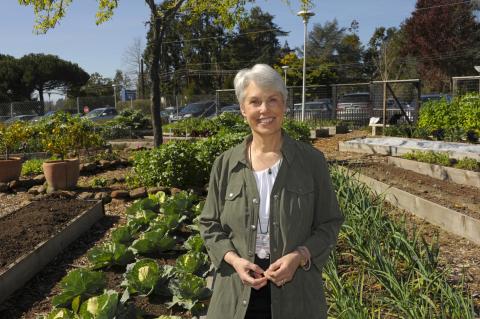
"I know it's a little thing, in a sense, but what it does, it just symbolizes so much more," Dominican Sr. Mary Ellen Leciejewski, vice president of corporate responsibility at Dignity Health, said of the hospital system's removal of plastic straws and stir sticks from its cafeterias.
The move, overseen by Dominican Sr. Mary Ellen Leciejewski in California's largest hospital provider and the nation's fifth-largest health system, was prompted by a 17-year-old girl. In November, Shelby O'Neil wrote a letter to Dignity Health CEO Lloyd Dean asking why a straw was featured in one of the health provider's commercials. For a Girl Scout project, O'Neil had organized beach cleanups and educated about the problems single-use plastics, like straws, pose to the oceans.
As a result, gone are the straws, along with plastic stir sticks, which together represent a reduction of 11,000 disposable plastics a day and 4 million a year.
"I know it's a little thing, in a sense, but what it does, it just symbolizes so much more… It takes a look at our consumerist lifestyle, our throwaway lifestyle. You know, we use this thing once and throw it away. So it is just something that says okay, maybe we need to look at this, maybe we really do not need this straw," said Leciejewski, Dignity Health vice president of corporate responsibility.
Opportunities to reduce waste are abound in a hospital, even more so in a system of three dozen facilities. Within each is a green team that coordinates with Leciejewski on various waste reduction or environmental programs. Those efforts have included reducing the supplies in operating room surgical packs to quantities more in line with what is typically used, reprocessing or reusing surgical instruments and pulse oximeters, and installing water filling stations to encourage reusable bottles.
In fiscal year 2017, Dignity Health recycled 34 percent of its waste. That included recycling 96 tons of "blue wrap," a material made of polypropylene #5 used to cover sterilized surgical instruments.
In 2014, the hospitals began recycling blue wrap, but it wasn't until a few months ago that Dignity Health found a reprocessor able to turn it into new materials, such as tote bags, recyclable bins, bed pans and water pitchers.
"So that's kind of like the circular economy," Leciejewski said. "Using the product, then once we're finished with it send it back and turn it into products, and then we're working on bringing those products back into the hospitals."
Still, there are things, like protective gloves and gowns, that simply can't be redirected from the trash bins because they're considered medical waste.
"Safety is paramount, that's first," Leciejewski said, in particular for the patient.
In the case of the straws, they remain for patients, and if family members request one, paper versions are still available. And while some in the hospitals have said they miss the straws, others have applauded the move, one becoming more common also in restaurants on the West Coast.
The culture in California has ingrained in many residents a tendency away from waste.
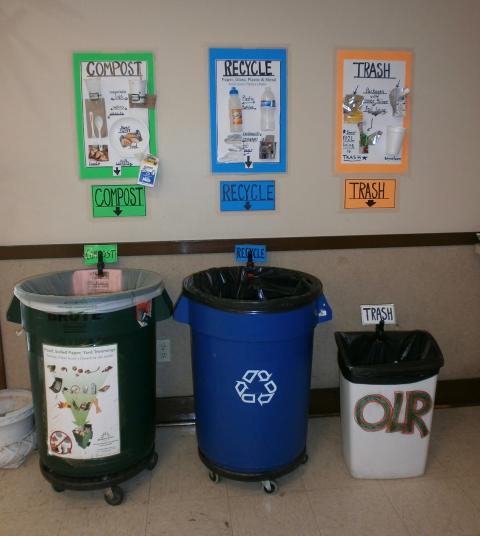
Waste disposal bins for composting, recycling and trash are used at St. Thomas Aquinas Parish, in Palo Alto, California. "You just have to continually remind people," said Katia Reeves, a member of the parish's green committee. (St. Thomas Aquinas Green Committee)
"I think it helps a lot, because it's in everybody's mind," said Katia Reeves, a parishioner at St. Thomas Aquinas Parish, in Palo Alto. "… There's not as much space as other states that are not as densely populated, so it's even more apparent that something needs to be done."
Aquinas, a cluster of three churches, began its waste reduction efforts about nine years ago, around the time it first saw the St. Francis Pledge created by the Catholic Climate Covenant. Since then, through its green committee, it's taken on numerous environmentally focused projects: swapping plastic foam cups and plastics in their kitchen for compostable plates, cups and cutlery, banning plastic water bottles and joining the statewide push for banning plastic bags in California, which voters did in November 2016.
The past two years, they've held a "free-cycle" event at the annual parish picnic, where parishioners bring usable but unwanted items that others can take home. Also at the parish picnic and other large events, they only set out recycle bins and compost bins. Inside the parish, landfill bins are present, but are smaller than the others as another effort to encourage a "less trash" mentality.
Since the fall, the smaller garbage bin concept has also been in place at the parish's school, St. Elizabeth Seton School. At an assembly, principal Evelyn Rosa explained to the students what goes where, demonstrating with a school meal on a compostable tray, and why they were making the shift.
"Way too much stuff was being thrown in landfill [bins] that needed to go in the compost," said vice principal Ellen Maguire. "… They just saw garbage cans the same size, the same color. One said compost, one said landfill, but they were just putting them in whatever they wanted to."
The students have caught on, even pointing out on field trips when the places they visit lack a compost bin. The visual cues on the bins are essential, the school leaders stressed, as is being deliberate about them and starting the education process at a young age.
Reeves has taken steps on her own to pass on recycling habits to the next generation. When she goes to the beach with her four grandkids, they bring with them bags to collect trash. She does the same when her nieces from Kansas City visit, who have taken the habit home, where they bring a bag on their jogs to collect items of trash they pass along the path.
Editor's note: This is part two of a three-part series. You can read part one here and part three here.
[Brian Roewe is an NCR staff writer. His email address is broewe@ncronline.org. Follow him on Twitter: @BrianRoewe.]





